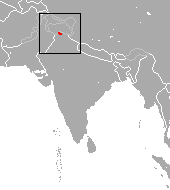| Kashmir gray langur | |
|---|---|
| Scientific classification | |
| Kingdom: | Animalia |
| Phylum: | Chordata |
| Class: | Mammalia |
| Order: | Primates |
| Suborder: | Haplorhini |
| Infraorder: | Simiiformes |
| Family: | Cercopithecidae |
| Genus: | Semnopithecus |
| Species: | S. ajax |
| Binomial name | |
| Semnopithecus ajax | |
 | |
| Kashmir gray langur range | |
The Kashmir gray langur (Semnopithecus ajax) is an Old World monkey, one of the langur species. It is a leaf-eating monkey. [2]
It has been reported from Jammu and Kashmir and Himachal Pradesh in northwestern India but evidence indicates it only occurs in the Chamba Valley in Himachal Pradesh. Because of its restricted range, fragmented population and threats from human agriculture and development activities it is listed as Endangered in the IUCN Red List. [1] In Pakistan it occurs in Machiara National Park. [3]
It was formerly considered a subspecies of Semnopithecus entellus and is one of several Semnopithecus species named after characters from The Iliad , along with Semnopithecus hector and Semnopithecus priam . [4]
